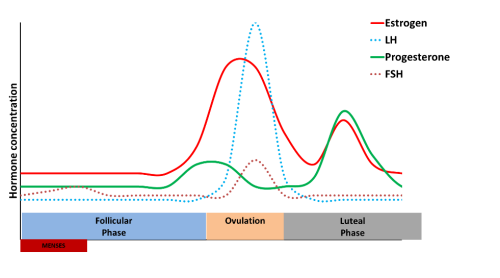Managing the menstrual cycle for optimal sport performance and injury risk reduction
by Gaynell Anderson, DPT, OMPT, CHC
With fluctuations of hormones during the menstrual cycle, the female athlete has unique physiological and psychological attributes that affect her athletic performance and injury risks.

The female menstrual cycle has four primary phases, each contributing to the ability to perform strength training, endurance training, proprioceptive training, or competition. These four phases are the Follicular phase, Ovulation, Luteal phase, and Menstruation. With varying hormone levels specific to each phase, improving sport ability can be as simple as increasing carbohydrates prior to and during sport activity, or increasing electrolytes during sport activity. More complicated adjustments involve types of training during the different phases of the menstrual cycle to optimize performance, when to strength train and when to endurance train.
Looking at each phase:
- Follicular phase-part 1: Early in this phase (during menstruation), hormone levels are low and pain tolerance is increased to prime the female body for maximized training efforts. Energy levels are at their peak and carbohydrate storage access is optimal, making this the best time for high intensity training and competition.
- Follicular Phase-part 2: Later in this phase, estrogen levels increase, and strength training becomes more effective. During this phase however, carbohydrate storage is reduced. Training suggestions during this phase may include increasing carbohydrate intake prior to and during sport activity to facilitate continued high intensity activity.
- Ovulation(about 2 weeks before menstruation): A noted increase in strength occurs in this phase, making this a good time for strength training. However, there is also increased incidence of ACL injury during this phase. This is attributed to increased quadriceps strength creating an imbalance between the quadriceps/hamstring strength, and ultimately stability in the knee. During this time, a female athlete should avoid activities that tend to strain the ACL. Box jumps and cutting drills are examples of such activities.
- Luteal Phase(about 1 week before menstruation): This is a poor time to compete aggressively, as the female body is not primed for high-intensity sport activity. Body mass is typically elevated due to an increase in fluid retention reducing muscle response times and ability to physically respond quickly. There is an increase in breathing and body temperature due to delayed onset of sweating, making it harder to perform in the heat. Sodium loss during this phase makes it important for the female athlete to increase electrolytes during physical activity to avoid dehydration.
Aside from the physiological changes occurring in the female body during the menstrual cycle, there are also psychological effects on performance. Feelings of worry, negative mood swings, and agitation associated with a sense of lack of control over symptoms can impact sport performance and interfere with focus. Psychological effects of the menstrual cycle are most prominent in those females with very irregular or highly symptomatic cycles (high cramping for example). Education and assistance with treatment of symptoms can be very helpful with improving a women’s sense of control over her situation. At times, oral contraception is an option to improve consistency and predictability of cycle and reduce overall severity of symptoms thus improving overall sport ability.
How can a female athlete stay competitive during all phases of her menstrual cycle? A model of care has been developed to improve female athletic performances. This model of care includes:
- Educationto increase awareness and understanding of effects of cycle on the female body optimizing performance in each cycle.
- Menstrual cycle Profiling: a comprehensive menstrual cycle history profile to determine individual nuances in menstrual cycle and develop best plan of action for the individual athlete.
- Monitor: daily monitoring of cycle phases and symptomology to be treated as necessary, optimizing sport performance and injury prevention.
- Point of Contact with an individual on the training team that the female athlete is comfortable communicating her concerns.
At TriCore Wellness, we have a team of nutritionists, physical therapists specializing in women’s health, and coaches to provide this model of care and training. With specialized tracking and guidance, the female athlete can optimize performance, prevent injuries, and take her game to the next level!
Contact us to get started today!
(239) 877-1481
References:
British Journal of Sports Medicine: Vol 54, Issue 18, “How the Menstrual Cycle and Menstruation Affect Sporting Performance: Experiences and Perceptions of Elite Female Rugby Players.”; Findlay, Macrae, Whyte, Easton, Forrest.
The Swedish Winter Sports Research Centre. “The Menstrual Cycle and Female Athletic Performance”; Mittuniversitetet Tues. 19, Feb.
The Washington Post Oct 19, 2019. “New Research on the Menstrual Cycle and Athletic Performance Helps Women Compete”; Amanda Loudin



